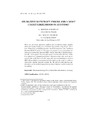Identificador persistente para citar o vincular este elemento:
https://accedacris.ulpgc.es/jspui/handle/10553/71018
| Campo DC | Valor | idioma |
|---|---|---|
| dc.contributor.author | Hernández Bastida, Agustín | en_US |
| dc.contributor.author | Martel Escobar, María del Carmen | en_US |
| dc.contributor.author | Vázquez Polo, Francisco José | en_US |
| dc.date.accessioned | 2020-03-23T16:59:23Z | - |
| dc.date.available | 2020-03-23T16:59:23Z | - |
| dc.date.issued | 1998 | en_US |
| dc.identifier.issn | 0210-8054 | en_US |
| dc.identifier.other | Dialnet | - |
| dc.identifier.uri | https://accedacris.ulpgc.es/handle/10553/71018 | - |
| dc.description.abstract | There are two basic questions auditors and accountants must consider when developing test and estimation applications using Bayes' Theorem: What prior probability function should be used and what likelihood function should be used. In this paper we propose to use a maximum entropy prior probability function MEP with the most likely likelihood function MLL in the Quasi-Bayesian QB model introduced by McCray (1984). It is defined on an adequate parameter. Thus procedure only needs an expected value of ?0 known (in this paper the expected tainting) to obtain a MEP all an auditor or accountant need to supply are the range, as with any other prior, and the expected tainting, ?0. We will see some practical applications of the methodology proposed about internal control evaluation in auditin. | en_US |
| dc.language | eng | en_US |
| dc.relation.ispartof | Questiio | en_US |
| dc.source | Questiió: Quaderns d'Estadística, Sistemes, Informatica i Investigació Operativa [ISSN 0210-8054],v. 22 (2), p. 231-242 | en_US |
| dc.subject | 530601 Economía, investigación y desarrollo experimental | en_US |
| dc.subject.other | Entropia | en_US |
| dc.subject.other | Auditoría | en_US |
| dc.subject.other | Auditing | en_US |
| dc.subject.other | Maximum Entropy Prior | en_US |
| dc.subject.other | Partial Prior Information | en_US |
| dc.title | On maximum entropy priors and a most likely likelihood in auditing | en_US |
| dc.type | info:eu-repo/semantics/Article | en_US |
| dc.type | Article | en_US |
| dc.identifier.url | http://dialnet.unirioja.es/servlet/articulo?codigo=2363828 | - |
| dc.description.lastpage | 242 | - |
| dc.identifier.issue | 2 | - |
| dc.description.firstpage | 231 | - |
| dc.relation.volume | 22 | - |
| dc.investigacion | Ciencias Sociales y Jurídicas | en_US |
| dc.type2 | Artículo | en_US |
| dc.contributor.authordialnetid | No ID | - |
| dc.contributor.authordialnetid | 1132051 | - |
| dc.contributor.authordialnetid | 243388 | - |
| dc.identifier.dialnet | 2363828ARTREV | - |
| dc.utils.revision | Sí | en_US |
| dc.identifier.ulpgc | Sí | es |
| item.grantfulltext | open | - |
| item.fulltext | Con texto completo | - |
| crisitem.author.dept | GIR TIDES- Técnicas estadísticas bayesianas y de decisión en la economía y empresa | - |
| crisitem.author.dept | IU de Turismo y Desarrollo Económico Sostenible | - |
| crisitem.author.dept | Departamento de Métodos Cuantitativos en Economía y Gestión | - |
| crisitem.author.dept | GIR TIDES- Técnicas estadísticas bayesianas y de decisión en la economía y empresa | - |
| crisitem.author.dept | IU de Turismo y Desarrollo Económico Sostenible | - |
| crisitem.author.dept | Departamento de Métodos Cuantitativos en Economía y Gestión | - |
| crisitem.author.orcid | 0000-0002-7013-4747 | - |
| crisitem.author.orcid | 0000-0002-0632-6138 | - |
| crisitem.author.parentorg | IU de Turismo y Desarrollo Económico Sostenible | - |
| crisitem.author.parentorg | IU de Turismo y Desarrollo Económico Sostenible | - |
| crisitem.author.fullName | Martel Escobar, María Carmen | - |
| crisitem.author.fullName | Vázquez Polo, Francisco José | - |
| Colección: | Artículos | |
Visitas
45
actualizado el 30-sep-2023
Descargas
50
actualizado el 30-sep-2023
Google ScholarTM
Verifica
Comparte
Exporta metadatos
Los elementos en ULPGC accedaCRIS están protegidos por derechos de autor con todos los derechos reservados, a menos que se indique lo contrario.
